CLWM4100 Taxation Law Assessment: CGT, Capital Gains and Losses Report
VerifiedAdded on 2022/08/21
|7
|1064
|11
Report
AI Summary
This report addresses a taxation law case study, focusing on the timing of a CGT event and the calculation of capital gains and losses. Part 1 explains the timing of a CGT event, referencing relevant sections of the ITAA 1997 and case law. Part 2 advises on the net capital gains or losses to be included in Harrison Carter's tax return for the years ending 2018 and 2019, including calculations using both discount and indexation methods. The report analyzes the sale of an investment property and the acquisition of shares, determining the applicable CGT event dates. It also covers the offsetting of capital losses. The report concludes with a recommendation on the most advantageous method for calculating capital gains to minimize tax liability. The report provides a comprehensive analysis of CGT implications for an Australian resident.
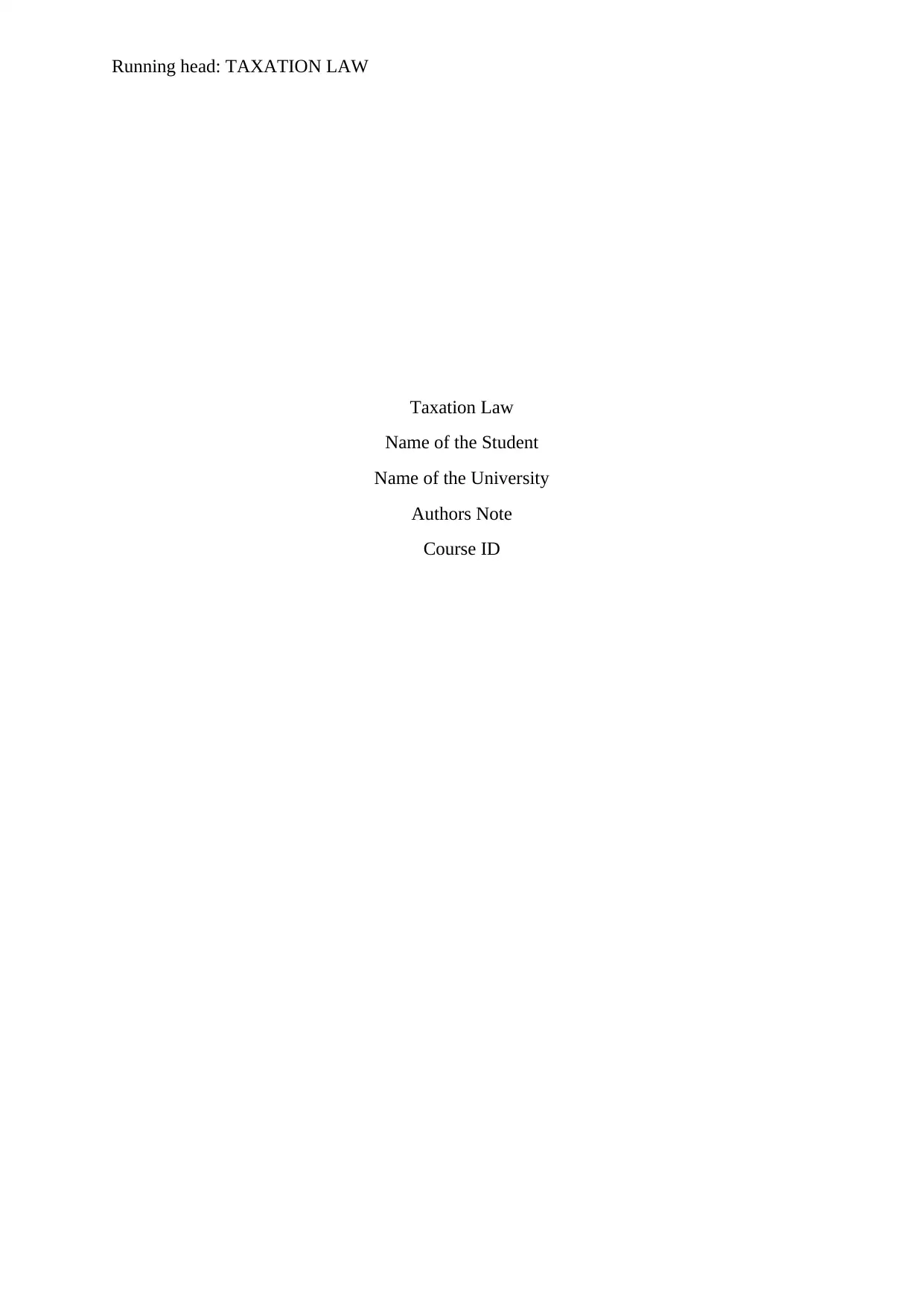
Running head: TAXATION LAW
Taxation Law
Name of the Student
Name of the University
Authors Note
Course ID
Taxation Law
Name of the Student
Name of the University
Authors Note
Course ID
Paraphrase This Document
Need a fresh take? Get an instant paraphrase of this document with our AI Paraphraser

1TAXATION LAW
Table of Contents
Answer to Part 1:........................................................................................................................2
Answer to Part 2:........................................................................................................................3
References:.................................................................................................................................6
Table of Contents
Answer to Part 1:........................................................................................................................2
Answer to Part 2:........................................................................................................................3
References:.................................................................................................................................6
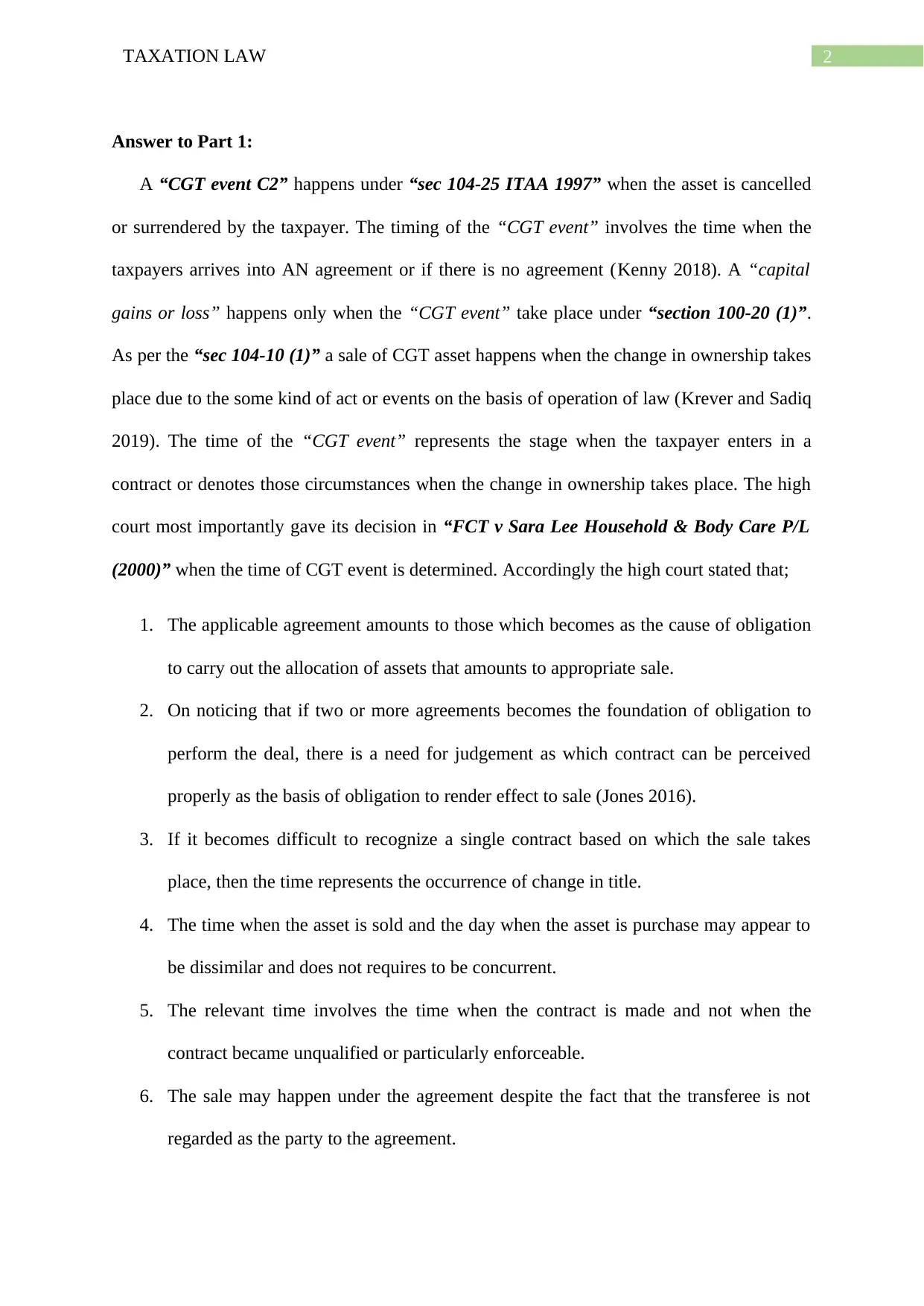
2TAXATION LAW
Answer to Part 1:
A “CGT event C2” happens under “sec 104-25 ITAA 1997” when the asset is cancelled
or surrendered by the taxpayer. The timing of the “CGT event” involves the time when the
taxpayers arrives into AN agreement or if there is no agreement (Kenny 2018). A “capital
gains or loss” happens only when the “CGT event” take place under “section 100-20 (1)”.
As per the “sec 104-10 (1)” a sale of CGT asset happens when the change in ownership takes
place due to the some kind of act or events on the basis of operation of law (Krever and Sadiq
2019). The time of the “CGT event” represents the stage when the taxpayer enters in a
contract or denotes those circumstances when the change in ownership takes place. The high
court most importantly gave its decision in “FCT v Sara Lee Household & Body Care P/L
(2000)” when the time of CGT event is determined. Accordingly the high court stated that;
1. The applicable agreement amounts to those which becomes as the cause of obligation
to carry out the allocation of assets that amounts to appropriate sale.
2. On noticing that if two or more agreements becomes the foundation of obligation to
perform the deal, there is a need for judgement as which contract can be perceived
properly as the basis of obligation to render effect to sale (Jones 2016).
3. If it becomes difficult to recognize a single contract based on which the sale takes
place, then the time represents the occurrence of change in title.
4. The time when the asset is sold and the day when the asset is purchase may appear to
be dissimilar and does not requires to be concurrent.
5. The relevant time involves the time when the contract is made and not when the
contract became unqualified or particularly enforceable.
6. The sale may happen under the agreement despite the fact that the transferee is not
regarded as the party to the agreement.
Answer to Part 1:
A “CGT event C2” happens under “sec 104-25 ITAA 1997” when the asset is cancelled
or surrendered by the taxpayer. The timing of the “CGT event” involves the time when the
taxpayers arrives into AN agreement or if there is no agreement (Kenny 2018). A “capital
gains or loss” happens only when the “CGT event” take place under “section 100-20 (1)”.
As per the “sec 104-10 (1)” a sale of CGT asset happens when the change in ownership takes
place due to the some kind of act or events on the basis of operation of law (Krever and Sadiq
2019). The time of the “CGT event” represents the stage when the taxpayer enters in a
contract or denotes those circumstances when the change in ownership takes place. The high
court most importantly gave its decision in “FCT v Sara Lee Household & Body Care P/L
(2000)” when the time of CGT event is determined. Accordingly the high court stated that;
1. The applicable agreement amounts to those which becomes as the cause of obligation
to carry out the allocation of assets that amounts to appropriate sale.
2. On noticing that if two or more agreements becomes the foundation of obligation to
perform the deal, there is a need for judgement as which contract can be perceived
properly as the basis of obligation to render effect to sale (Jones 2016).
3. If it becomes difficult to recognize a single contract based on which the sale takes
place, then the time represents the occurrence of change in title.
4. The time when the asset is sold and the day when the asset is purchase may appear to
be dissimilar and does not requires to be concurrent.
5. The relevant time involves the time when the contract is made and not when the
contract became unqualified or particularly enforceable.
6. The sale may happen under the agreement despite the fact that the transferee is not
regarded as the party to the agreement.
⊘ This is a preview!⊘
Do you want full access?
Subscribe today to unlock all pages.

Trusted by 1+ million students worldwide
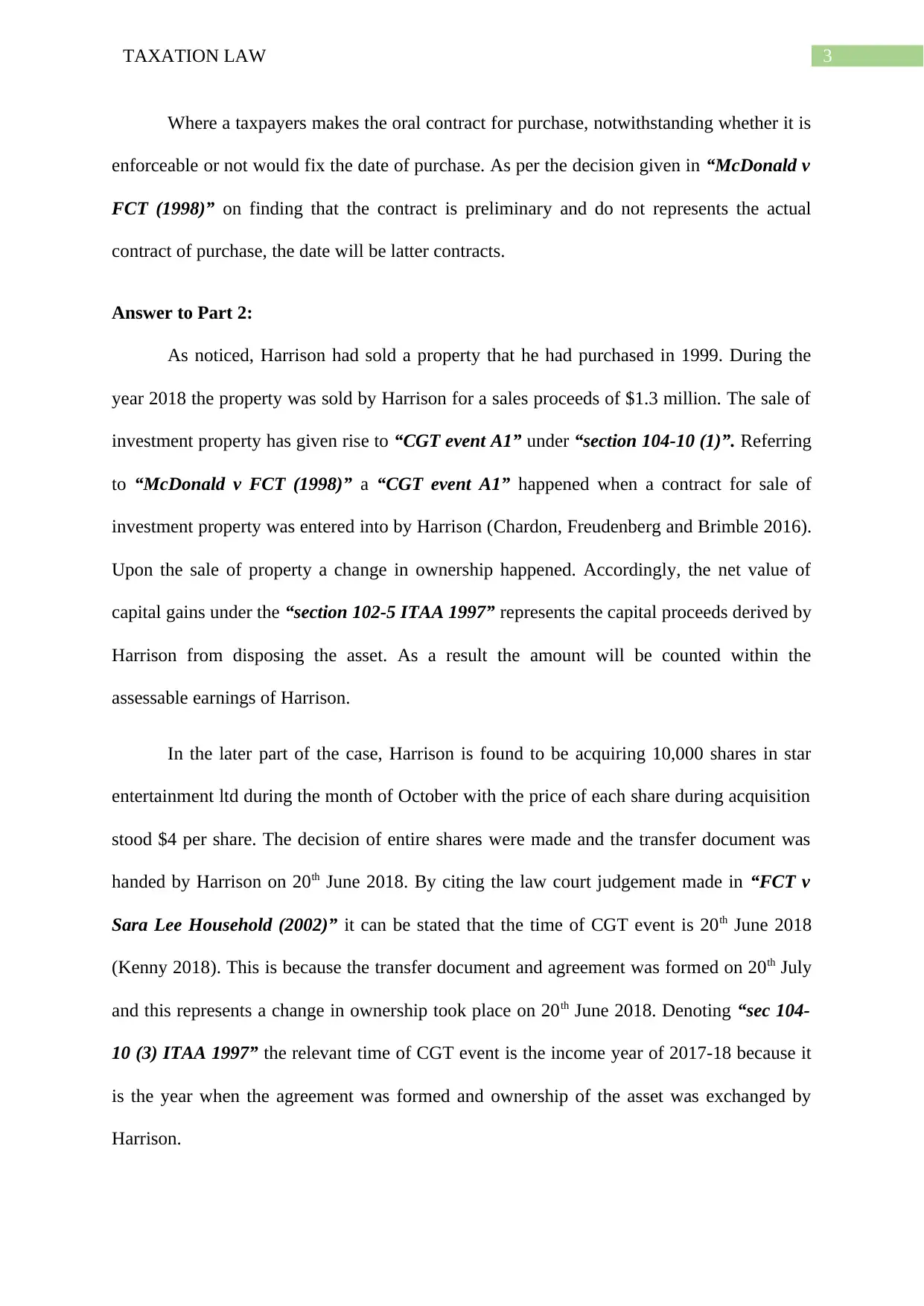
3TAXATION LAW
Where a taxpayers makes the oral contract for purchase, notwithstanding whether it is
enforceable or not would fix the date of purchase. As per the decision given in “McDonald v
FCT (1998)” on finding that the contract is preliminary and do not represents the actual
contract of purchase, the date will be latter contracts.
Answer to Part 2:
As noticed, Harrison had sold a property that he had purchased in 1999. During the
year 2018 the property was sold by Harrison for a sales proceeds of $1.3 million. The sale of
investment property has given rise to “CGT event A1” under “section 104-10 (1)”. Referring
to “McDonald v FCT (1998)” a “CGT event A1” happened when a contract for sale of
investment property was entered into by Harrison (Chardon, Freudenberg and Brimble 2016).
Upon the sale of property a change in ownership happened. Accordingly, the net value of
capital gains under the “section 102-5 ITAA 1997” represents the capital proceeds derived by
Harrison from disposing the asset. As a result the amount will be counted within the
assessable earnings of Harrison.
In the later part of the case, Harrison is found to be acquiring 10,000 shares in star
entertainment ltd during the month of October with the price of each share during acquisition
stood $4 per share. The decision of entire shares were made and the transfer document was
handed by Harrison on 20th June 2018. By citing the law court judgement made in “FCT v
Sara Lee Household (2002)” it can be stated that the time of CGT event is 20th June 2018
(Kenny 2018). This is because the transfer document and agreement was formed on 20th July
and this represents a change in ownership took place on 20th June 2018. Denoting “sec 104-
10 (3) ITAA 1997” the relevant time of CGT event is the income year of 2017-18 because it
is the year when the agreement was formed and ownership of the asset was exchanged by
Harrison.
Where a taxpayers makes the oral contract for purchase, notwithstanding whether it is
enforceable or not would fix the date of purchase. As per the decision given in “McDonald v
FCT (1998)” on finding that the contract is preliminary and do not represents the actual
contract of purchase, the date will be latter contracts.
Answer to Part 2:
As noticed, Harrison had sold a property that he had purchased in 1999. During the
year 2018 the property was sold by Harrison for a sales proceeds of $1.3 million. The sale of
investment property has given rise to “CGT event A1” under “section 104-10 (1)”. Referring
to “McDonald v FCT (1998)” a “CGT event A1” happened when a contract for sale of
investment property was entered into by Harrison (Chardon, Freudenberg and Brimble 2016).
Upon the sale of property a change in ownership happened. Accordingly, the net value of
capital gains under the “section 102-5 ITAA 1997” represents the capital proceeds derived by
Harrison from disposing the asset. As a result the amount will be counted within the
assessable earnings of Harrison.
In the later part of the case, Harrison is found to be acquiring 10,000 shares in star
entertainment ltd during the month of October with the price of each share during acquisition
stood $4 per share. The decision of entire shares were made and the transfer document was
handed by Harrison on 20th June 2018. By citing the law court judgement made in “FCT v
Sara Lee Household (2002)” it can be stated that the time of CGT event is 20th June 2018
(Kenny 2018). This is because the transfer document and agreement was formed on 20th July
and this represents a change in ownership took place on 20th June 2018. Denoting “sec 104-
10 (3) ITAA 1997” the relevant time of CGT event is the income year of 2017-18 because it
is the year when the agreement was formed and ownership of the asset was exchanged by
Harrison.
Paraphrase This Document
Need a fresh take? Get an instant paraphrase of this document with our AI Paraphraser
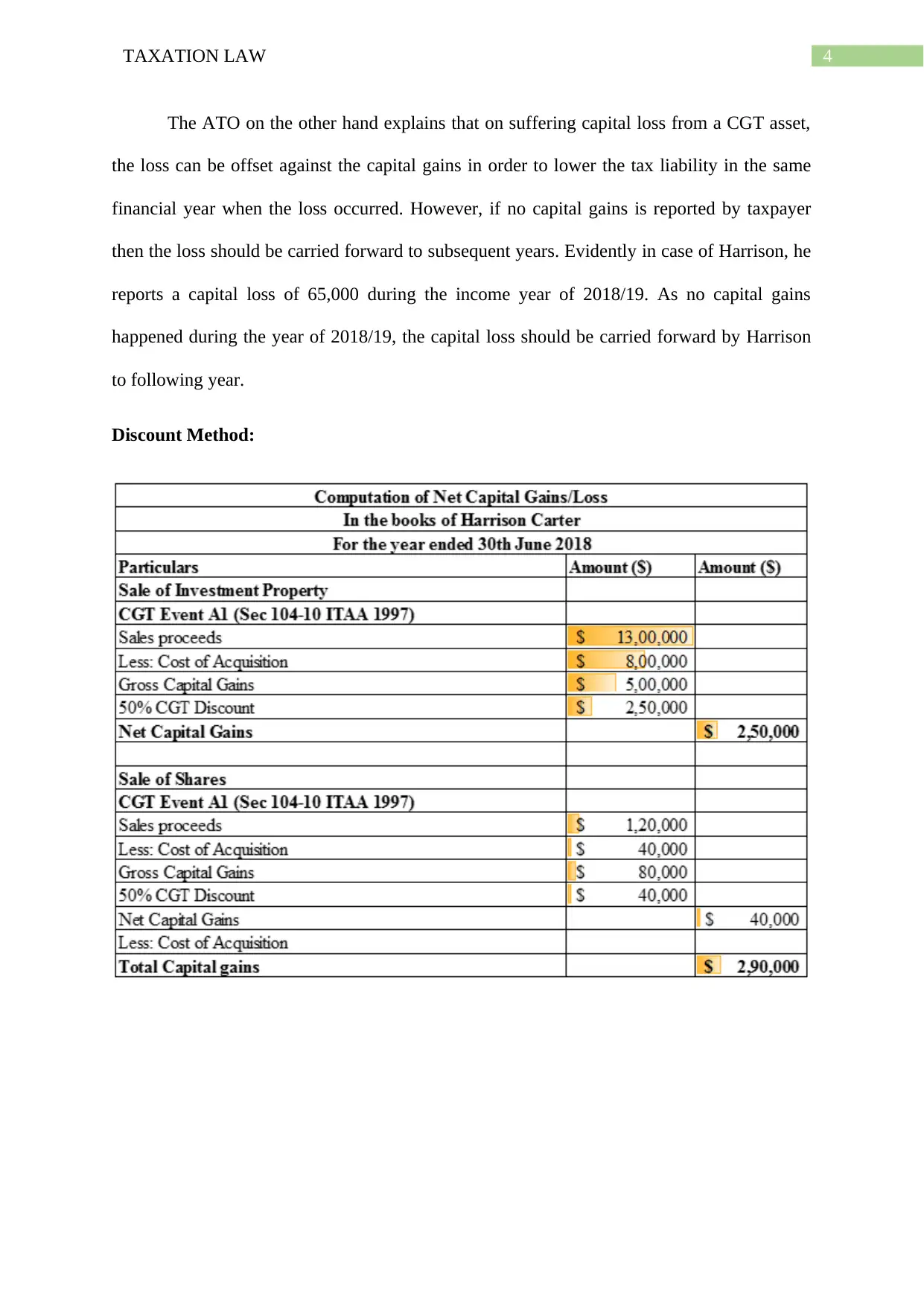
4TAXATION LAW
The ATO on the other hand explains that on suffering capital loss from a CGT asset,
the loss can be offset against the capital gains in order to lower the tax liability in the same
financial year when the loss occurred. However, if no capital gains is reported by taxpayer
then the loss should be carried forward to subsequent years. Evidently in case of Harrison, he
reports a capital loss of 65,000 during the income year of 2018/19. As no capital gains
happened during the year of 2018/19, the capital loss should be carried forward by Harrison
to following year.
Discount Method:
The ATO on the other hand explains that on suffering capital loss from a CGT asset,
the loss can be offset against the capital gains in order to lower the tax liability in the same
financial year when the loss occurred. However, if no capital gains is reported by taxpayer
then the loss should be carried forward to subsequent years. Evidently in case of Harrison, he
reports a capital loss of 65,000 during the income year of 2018/19. As no capital gains
happened during the year of 2018/19, the capital loss should be carried forward by Harrison
to following year.
Discount Method:
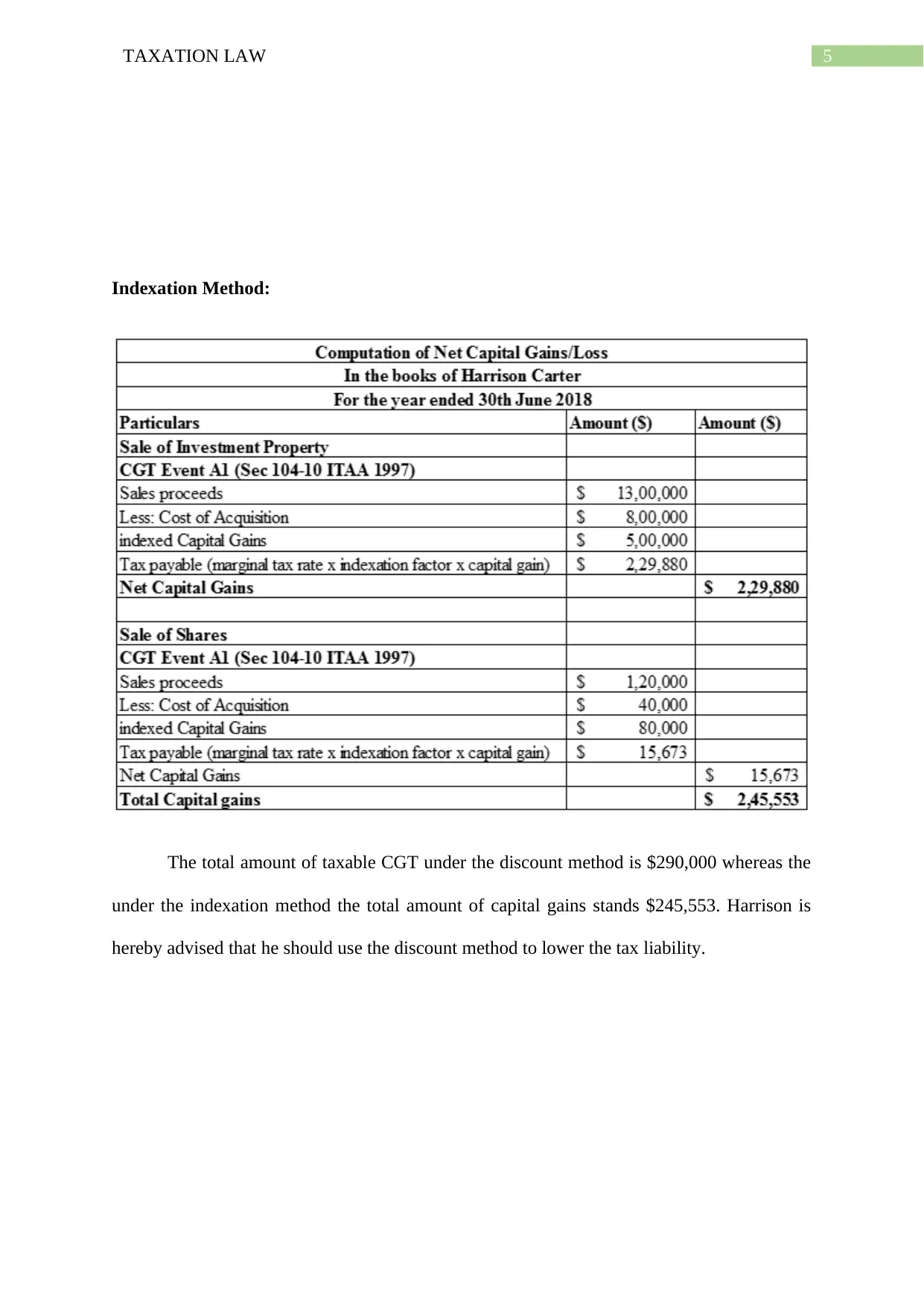
5TAXATION LAW
Indexation Method:
The total amount of taxable CGT under the discount method is $290,000 whereas the
under the indexation method the total amount of capital gains stands $245,553. Harrison is
hereby advised that he should use the discount method to lower the tax liability.
Indexation Method:
The total amount of taxable CGT under the discount method is $290,000 whereas the
under the indexation method the total amount of capital gains stands $245,553. Harrison is
hereby advised that he should use the discount method to lower the tax liability.
⊘ This is a preview!⊘
Do you want full access?
Subscribe today to unlock all pages.

Trusted by 1+ million students worldwide
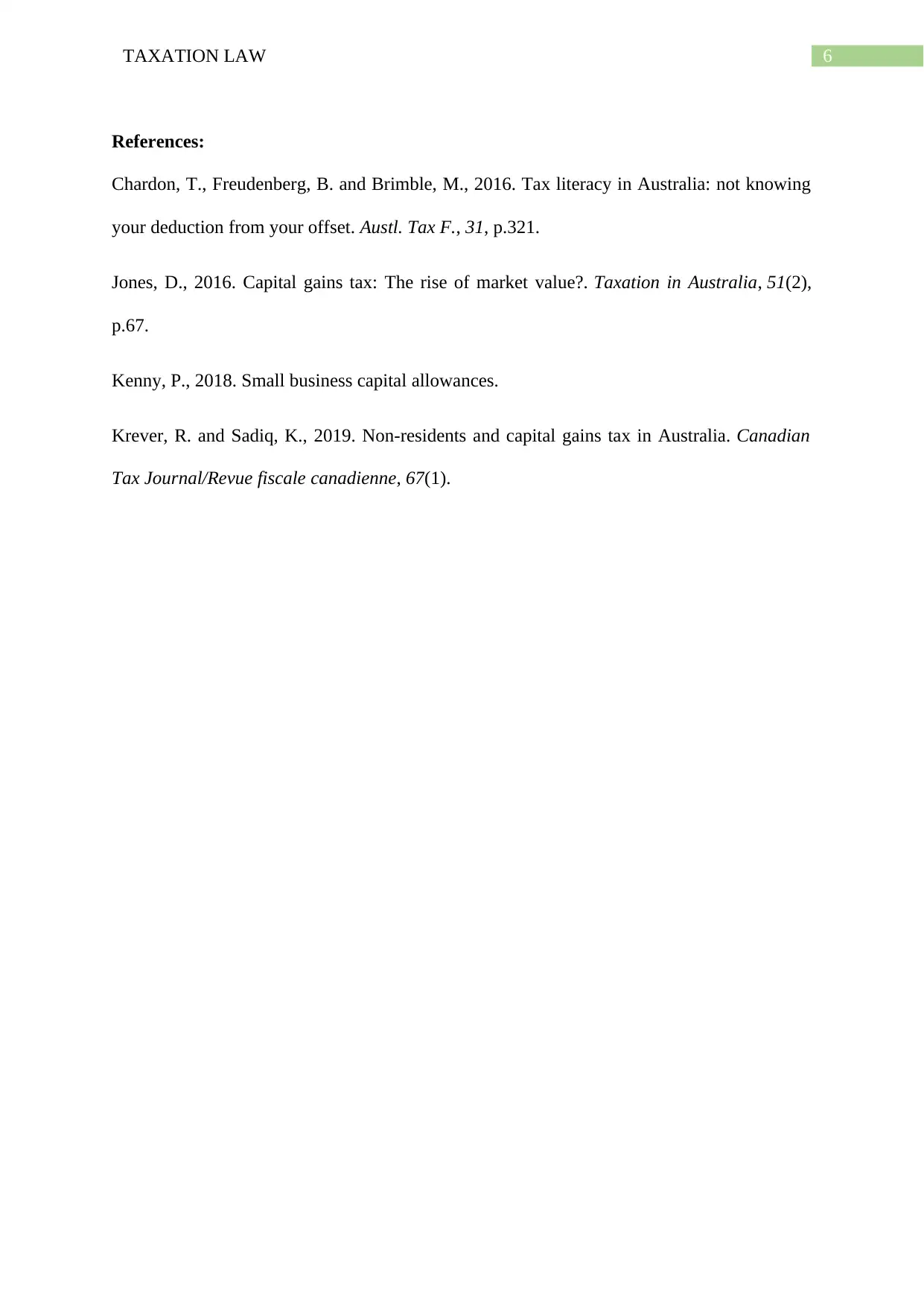
6TAXATION LAW
References:
Chardon, T., Freudenberg, B. and Brimble, M., 2016. Tax literacy in Australia: not knowing
your deduction from your offset. Austl. Tax F., 31, p.321.
Jones, D., 2016. Capital gains tax: The rise of market value?. Taxation in Australia, 51(2),
p.67.
Kenny, P., 2018. Small business capital allowances.
Krever, R. and Sadiq, K., 2019. Non-residents and capital gains tax in Australia. Canadian
Tax Journal/Revue fiscale canadienne, 67(1).
References:
Chardon, T., Freudenberg, B. and Brimble, M., 2016. Tax literacy in Australia: not knowing
your deduction from your offset. Austl. Tax F., 31, p.321.
Jones, D., 2016. Capital gains tax: The rise of market value?. Taxation in Australia, 51(2),
p.67.
Kenny, P., 2018. Small business capital allowances.
Krever, R. and Sadiq, K., 2019. Non-residents and capital gains tax in Australia. Canadian
Tax Journal/Revue fiscale canadienne, 67(1).
1 out of 7
Related Documents
Your All-in-One AI-Powered Toolkit for Academic Success.
+13062052269
info@desklib.com
Available 24*7 on WhatsApp / Email
![[object Object]](/_next/static/media/star-bottom.7253800d.svg)
Unlock your academic potential
Copyright © 2020–2025 A2Z Services. All Rights Reserved. Developed and managed by ZUCOL.





